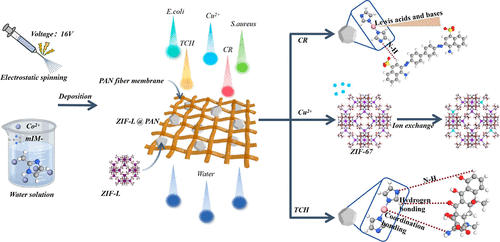Chemistry of Materials, https://doi.org/10.1021/acs.chemmater.4c03010
Abstract
A composite adsorption filter membrane that is efficient, fast, and recyclable was created in order to boost the adsorption capacity and reduce loss during application. We created a polyacrylonitrile (PAN) fiber membrane using electrospinning technology as a composite adsorbent substrate material. After that, we stirred the membrane at room temperature to deposit a two-dimensional flaky zeolitic imidazolate framework (ZIF-L) on the PAN substrate’s surface. Better thermal stability, multipore size distribution, high specific surface area, and good crystallinity are all features of the synthesized ZIF-L@PAN composite fiber membrane The composite membrane demonstrated high efficiency and universality in adsorbing and removing various water pollutants, along with good antibacterial properties. The synthesized fiber composite membrane exhibits a more pronounced adsorption capacity at pH values of 7 to 8 when compared to ZIF-L and PAN membranes. Accordingly, the 10 mg composite membrane’s adsorption capacity for 500 mg/L pollutants [tetracycline hydrochloride, sulfamethoxazole, Congo red (CR), methylene blue, and Cu2+] was 437.74, 401.73, 497.83, 425.39, and 437.76 mg/g, respectively. Simultaneous adsorption is carried out through multiple steps. Intraparticle diffusion is not the only rate-controlling step. Adsorption is chemical adsorption. Notably, ZIF-L@PAN exhibits outstanding cycle stability and a maximum adsorption capacity of 3915.14 mg/g for CR. By designing a multipurpose adsorption filter membrane that can remove refractory, organic, and inorganic pollutants, this study hopes to make it easier to filter and purify different kinds of sewage.

